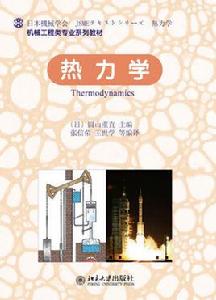基本信息
書號:19509 ISBN:978-7-301-19509-3作者:(日)圓山重直
版次:1
開本:大16開
裝訂:平
字數:411 千字 頁數:220
定價:¥34.00
出版日期:2011-10-27
叢書名:機械工程類專業系列教材
內容簡介
全書共分10章。第1章講述學習熱力學的意義、歷史背景以及本書的使用方法;第2章是熱力學基本概念和熱力學第零定律;第3章和第4章分別講述熱力學第一定律和第二定律及相關內容;第5章講述的是各種能源有效利用與火用之間的關係以及如何才能有效利用能源;第6章是熱力學的一般關係式;第7章是從熱力學的角度出發,講述了化學反應和燃燒,包括與之相關的環境、能源問題;第8章是與能源轉換密切相關的氣體循環;第9章是蒸汽熱力學循環;第10章講述的是各種製冷熱力學循環和空氣調節方面的內容。全書注重啟發讀者對熱力學及能源轉換相關內容的感性認識和深入思考,有許多易於理解的圖表,同時也注重到新知識面的更新、拓寬。
本書特點
1. 編者眾多且皆為在各自研究領域有所成就的專家;
2. 內容為眾多編者反覆討論而最終成稿;
3. 圖表配置在相應頁的邊緣部分並採用雙色印刷以便於閱讀;
4. 主要專業術語均有英文註解並配有顏色突出顯示,從而重點突出易於學習;
5. 參考美國的FE考試(Fundamentals of Engineering Examination),習題集採用了部分英語習題。
章節目錄
第1章概論(Introduction)1
1.1熱力學的意義 (significance of thermodynamics)1
1.2熱與熱力學(heat and thermodynamics)2
?1?3熱力學的歷史背景(historical background of thermodynamics)3
1.4本書的使用方法(how to use this book) 5
第2章基本概念及熱力學第零定律
(Basic Concepts and the Zeroth Law of Thermodynamics)7
2.1系統、物質、能量 (system, matter and energy)7
2.1.1系統(system)7
2.1.2閉口系統和開口系統(closed and open systems)7
2.1.3能量的形態(forms of energy)8
2.1.4能量的巨觀及微觀形態
(macroscopic and microscopic forms of energy)8
2.1.5內能(internal energy)9
?2.2熱力學的微觀解釋 (microscopic understanding of thermodynamics)9
2.2.1質點系統的內能(internal energy of point?mass system)9
2.2.2分子運動和物質的狀態及相變
(molecular motions, states of matter and phase changes)10
2.3溫度與熱平衡(熱力學第零定律)
(temperature and thermal equilibrium (the zeroth law of thermodynamics))12
2.3.1熱平衡(熱力學第零定律)
(thermal equilibrium, the zeroth law of thermodynamics)12
2.3.2溫度(temperature)13
2.4熱量和比熱 (heat and specific heat)13
2.5狀態量 (quantity of state)14
2.6單位制和單位(system unit, unit)14
2.6.1SI(the international system of units)14
2.6.2SI以外的單位制和單位(other system of units)16
第3章熱力學第一定律(The First Law of Thermodynamics)19
3.1熱與功 (heat and work)19
3.1.1熱(heat)19
3.1.2功(work)19
3.2閉口系統的熱力學第一定律 (the first law applied to closed system)20
熱力學目錄3.3熱力學平衡與準靜態過程
(thermodynamic equilibrium and quasi?static process)23
3.3.1熱力學平衡(thermodynamical equilibrium)23
3.3.2準靜態過程(quasi?static process)23
?3.3.3可逆過程與不可逆過程(reversible and irreversible processes)24
3.4閉口系統準靜態過程的熱力學第一定律
(the first law applied to quasi?static process of closed system)25
3.4.1熱力學第一定律(the first law of thermodynamics)25
3.4.2準靜態循環過程的淨功
(net work during quasi?static process of cycle)25
3.4.3定容過程與定壓過程
(specific heats at constant volume and constant pressure)26
3.5開口系統的熱力學第一定律 (the first law applied to open system)27
3.5.1定常流動系統的質量守恆定律
(steady flow system and conservation of mass)27
3.5.2流動功與焓(flow work and enthalpy)27
3.5.3定常流動系統的能量守恆定律
(energy conservation of steady flow system)28
3.5.4各種機械設備中的定常流動系統
(steady flow system in machinery)29
3.6理想氣體的熱力學第一定律 (the first law applied to ideal gas)32
3.6.1理想氣體與內能(ideal gas and internal energy)32
?3.6.2理想氣體的比熱(specific heat of ideal gas)33
3.6.3理想氣體的準靜態過程(quasi?static processes of ideal gas)35
?3.6.4混合理想氣體(ideal gas mixture)39
第4章熱力學第二定律(The Second Law of Thermodynamics)43
4.1熱功轉換效率: 卡諾的功績
(conversion efficiency from heat to work: Carnot?s achievement)43
4.1.1熱效率有上限嗎?(upper limit of thermal efficiency?)43
4.1.2卡諾的思考(Carnot?s reflections)44
4.2熱機的模型化(thermodynamic modeling of heat engine) 46
4.2.1循環(cycle)46
4.2.2可逆過程與不可逆過程(reversible and irreversible processes)48
?4.2.3內部可逆過程(internally reversible processes)49
4.3卡諾循環的性質(characteristics of Carnot cycle) 50
4.4閉口系統的第二定律(the second law for closed systems)53
4.4.1與單一熱源作用的循環: 第二定律的語言表述(cycle in contact with one
heat reservoir——the second law by statements)54
4.4.2與兩個熱源作用的循環(cycle in contact with two heat reservoirs)55
4.4.3與n個熱源作用的循環(cycle in contact with n heat reservoirs)55
4.5熵(Entropy)57
4.5.1狀態參數熵的定義(entropy as thermodynamic property)57
4.5.2閉口系統的熵平衡(不可逆過程的熵產)(entropy balance for closed
systems:entropy generation by irreversible processes)58
4.5.3開口系統的熵平衡: 開口系統的第二定律(entropy balance for open
systems: the second law for open systems)60
4.5.4第二定律、熵以及熵產的總結(some remarks about the second law,
entropy and entropy generation)60
4.6熵的工程套用(use of entropy for engineering applications)61
4.6.1熵變的關係式: TdS關係式
(equations for entropy change: TdS equations)61
4.6.2理想氣體的熵變(entropy change of ideal gases)62
4.6.3液體、固體的熵變(entropy change of liquids and solids)63
4.6.4用蒸汽表計算熵變
(calculation of entropy change using steam tables)63
?4.6.5熵產的計算(calculation of entropy generation)64
4.6.6含有熵參數的圖,熵的圖解利用
(property diagram involving entropy, graphical utilization of entropy)67
第5章能源的有效利用及
(Effective Utilization of Energy Resource and Exergy)69
5.1分析的必要性(background of exergy analysis)69
從熱力學第二定律到(from the second law to exergy)69
5.2做功的潛在能力: 最大功(ability to generate work: maximum work)70
5.2.1最大功(maximum work)70
5.2.2周圍環境對(最大功)的影響(effects of surroundings on exergy)72
5.2.3的基礎知識小結(some remarks about basis of exergy)75
5.2.4效率(exergetic efficiency)75
5.3各種系統的 (exergy of important systems) 77
5.3.1熱源利用系統(system utilizing heat from heat reservoir)77
5.3.2閉口系統(非流動過程)(closed system, nonflow process)77
5.3.3定常流動系統(steady flow system)80
?5.3.4開口系統 (open system)81
5.4自由能(free energy)81
5.4.1吉布斯自由能(Gibbs free energy)81
5.4.2亥姆霍茲自由能(Helmholtz free energy)83
?5.4.3平衡條件與自由能(化學反應的進行方向)
(equilibrium conditions and free energy)84
?5.5損失(lost exergy)85
不可逆過程及損失(irreversible processes and lost exergy)86
第6章熱力學一般關係式(General Thermodynamic Relation)89
6.1熱力學一般關係式(general thermodynamic relation)89
6.2從能量關係式導出一般關係式(general relations from energy equation)91
6.3比熱的一般關係式(general relations from specific heat)93
6.4內能和焓的一般關係式
(general relations from internal energy and enthalpy changes)96
6.5焦耳?湯姆遜效應(Joule?Thomson effect)98
6.6相平衡和克拉珀龍?克勞修斯方程
(phase equilibrium and Clapeyron?Clausius equation)99
第7章化學反應和燃燒(Chemical Reaction and Combustion)103
7.1化學反應、燃燒及環境問題
(chemical reaction, com?bustion and environmental problems)103
7.2化學反應和能量轉換(chemical reaction and energy conversion)105
7.2.1反應熱和標準生成焓
(heat of reaction and standard enthalpy of formation)105
7.2.2化學反應中吉布斯自由能的變化
(Gibbs free energy change in chemical reaction)107
7.2.3標準生成吉布斯自由能和能量轉換
(standard Gibbs free energy of formation and energy conversion)109
7.3化學平衡(chemical equilibrium)111
?7.3.1反應速率(reaction rate)111
7.3.2反應速度和化學平衡(reaction rate and chemical equilibrium)112
7.3.3化學平衡的條件(condition of chemical equilibrium)112
7.3.4平衡常數(equilibrium constant)113
7.3.5溫度和壓力對化學平衡的影響
(effects of temperature and pressure on chemical equilibrium)115
7.3.6一般情況下的化學平衡組成求解方法
(chemical equilibrium in general cases)117
7.3.7平衡常數的注意事項(rules of equilibrium constant)119
7.4燃燒(combustion)119
7.4.1燃料(fuel)120
7.4.2燃燒的形式(combustion forms)120
?7.4.3燃燒的反應機理(reaction mechanism of combustion)120
7.4.4空燃比、燃空比、空氣比、當量比
(air?fuel ratio, fuel?air ratio,air ratio, equivalence ratio)122
7.4.5燃燒的能量平衡(Energy balance in combustion)123
7.4.6理論火焰溫度(theoretical flame temperature)124
7.4.7燃燒和能量交換(combustion and energy conversion)126
第8章氣體循環(Gas Cycle)131
8.1熱機與循環(heat engine and cycle)131
8.2活塞式發動機的循環(piston?engine cycle)134
8.2.1奧托循環(Otto cycle)134
8.2.2狄塞爾循環(Diesel cycle)136
8.2.3薩巴特循環(Sabathé cycle)137
?8.2.4活塞式發動機的燃燒分析(combustion analysis in piston engines)138
8.2.5斯特林循環(Stirling cycle)139
8.3燃氣輪機發動機的循環(gas?turbine engine cycle)139
8.3.1布雷頓循環(Brayton cycle)140
8.3.2布雷頓回熱循環(regenerative Brayton cycle)141
8.3.3埃里克森循環(Ericsson cycle)142
8.3.4噴氣式發動機循環(jet?engine cycle)142
8.4氣體製冷循環(gas refrigeration cycle)142
第9章蒸汽循環(Vapor Cycle)147
9.1蒸汽的物性(properties of vapor)147
9.1.1相平衡與狀態變化(phase equilibrium and transition)147
9.1.2濕蒸汽性質(properties of wet vapor)148
9.2相平衡和克拉珀龍?克勞修斯方程
(phase equilibrium and Clapeyron?Clausius equation)149
9.2.1相平衡的條件(conditions for phase equlibrium)149
?9.2.2多組分混合物的兩相平衡
(two?phase equilibrium of multi?component mixtures)150
9.2.3克拉珀龍?克勞修斯方程(Clapeyron?Clausius equation)151
9.3實際氣體狀態方程(equation of state)152
9.3.1范德華方程(Van der Waals equation)152
?9.3.2實用狀態方程式(practical equation of state)154
9.4蒸汽動力循環(vapor power cycles)154
9.4.1朗肯循環(Rankine cycle)155
9.4.2再熱循環(reheat cycle)157
9.4.3再生循環(regenerative cycle)158
9.4.4聯合循環(combined cycle)159
第10章製冷循環與空調(Refrigeration Cycle and Air Conditioning)163
10.1製冷原理(principle of refrigeration)163
10.1.1可逆絕熱膨脹(reversible adiabatic expansion)163
10.1.2節流膨脹(throttle expansion)163
10.2工作性能係數(coefficient of performance)164
10.3各種製冷循環(refrigeration cycle)165
10.3.1逆卡諾循環(inverse Carnot cycle)165
10.3.2蒸汽壓縮式製冷循環(vapor compression refrigeration cycle)165
?10.3.3吸收式製冷循環(absorption refrigeration cycle)168
?10.3.4空氣製冷循環(air refrigeration cycle)170
?10.3.5液化循環(liquefaction cycle)170
10.4空氣調節(air conditioning)171
10.4.1濕空氣的性質(properties of moist air) 171
10.4.2濕空氣溫濕圖(psychrometric chart)173
附錄1 179
附錄2 187
附錄3 193
作者簡介
北京大學工學院教授、主任,任日本東北大學流體科學研究所講師、日本同志社大學能源研究中心高級研究員等職,現任北京大學工學院能源與資源工程系教授、挪威科學技術大學客座教授、日本同志社大學訪問教授等職。
書評
這本《熱力學》教材是在吸收日本機械學會原有資料精華的基礎上編譯而成的。著作系統地講述了熱力學的系統理論;將熱力學與當前所關心的節能減排相結合,運用熱力學手段解決能源短缺問題,可以對構築和諧的、可持續發展的社會起到巨大作用;同時可以充分理解熱力學中的一些非常難以理解的物理量,形象簡潔;運用這些物理量解決能源與環境問題等;將冷凍與空調等科學充分地建立在熱力學的認知基礎之上。

